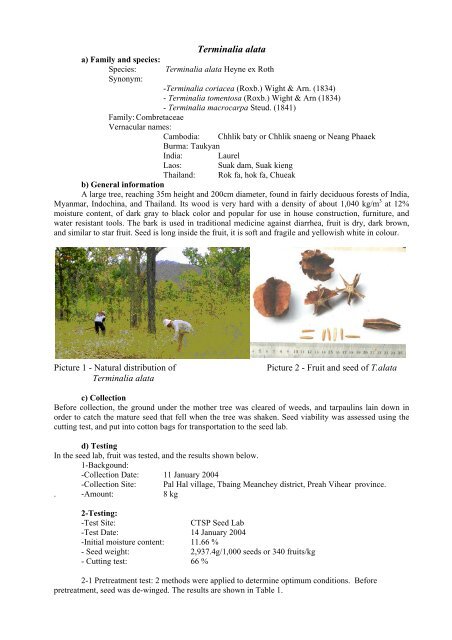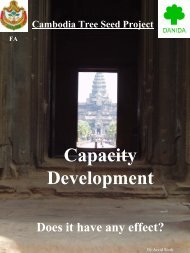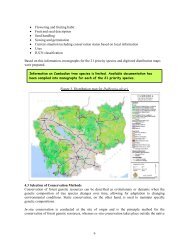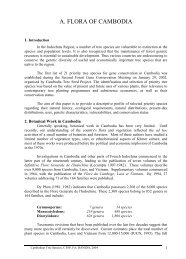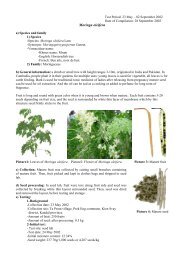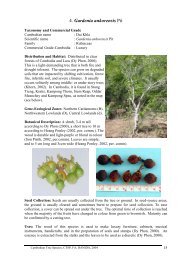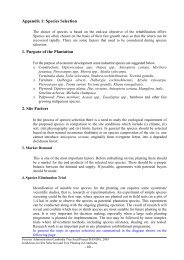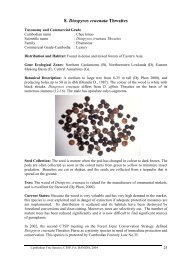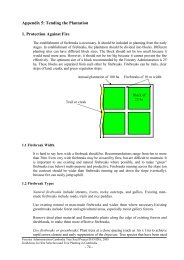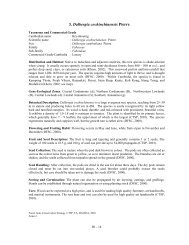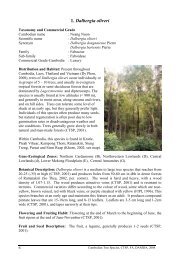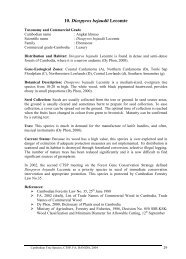Terminalia alata - Cambodia Tree Seed Project
Terminalia alata - Cambodia Tree Seed Project
Terminalia alata - Cambodia Tree Seed Project
Create successful ePaper yourself
Turn your PDF publications into a flip-book with our unique Google optimized e-Paper software.
<strong>Terminalia</strong> <strong>alata</strong><br />
a) Family and species:<br />
Species: <strong>Terminalia</strong> <strong>alata</strong> Heyne ex Roth<br />
Synonym:<br />
-<strong>Terminalia</strong> coriacea (Roxb.) Wight & Arn. (1834)<br />
- <strong>Terminalia</strong> tomentosa (Roxb.) Wight & Arn (1834)<br />
- <strong>Terminalia</strong> macrocarpa Steud. (1841)<br />
Family: Combretaceae<br />
Vernacular names:<br />
<strong>Cambodia</strong>: Chhlik baty or Chhlik snaeng or Neang Phaaek<br />
Burma: Taukyan<br />
India: Laurel<br />
Laos: Suak dam, Suak kieng<br />
Thailand: Rok fa, hok fa, Chueak<br />
b) General information<br />
A large tree, reaching 35m height and 200cm diameter, found in fairly deciduous forests of India,<br />
Myanmar, Indochina, and Thailand. Its wood is very hard with a density of about 1,040 kg/m 3 at 12%<br />
moisture content, of dark gray to black color and popular for use in house construction, furniture, and<br />
water resistant tools. The bark is used in traditional medicine against diarrhea, fruit is dry, dark brown,<br />
and similar to star fruit. <strong>Seed</strong> is long inside the fruit, it is soft and fragile and yellowish white in colour.<br />
Picture 1 - Natural distribution of<br />
<strong>Terminalia</strong> <strong>alata</strong><br />
Picture 2 - Fruit and seed of T.<strong>alata</strong><br />
c) Collection<br />
Before collection, the ground under the mother tree was cleared of weeds, and tarpaulins lain down in<br />
order to catch the mature seed that fell when the tree was shaken. <strong>Seed</strong> viability was assessed using the<br />
cutting test, and put into cotton bags for transportation to the seed lab.<br />
d) Testing<br />
In the seed lab, fruit was tested, and the results shown below.<br />
1-Backgound:<br />
-Collection Date: 11 January 2004<br />
-Collection Site: Pal Hal village, Tbaing Meanchey district, Preah Vihear province.<br />
. -Amount: 8 kg<br />
2-Testing:<br />
-Test Site:<br />
CTSP <strong>Seed</strong> Lab<br />
-Test Date: 14 January 2004<br />
-Initial moisture content: 11.66 %<br />
- <strong>Seed</strong> weight: 2,937.4g/1,000 seeds or 340 fruits/kg<br />
- Cutting test: 66 %<br />
2-1 Pretreatment test: 2 methods were applied to determine optimum conditions. Before<br />
pretreatment, seed was de-winged. The results are shown in Table 1.
No<br />
1<br />
2<br />
Moisture<br />
content<br />
11.66%<br />
Table 1 - Results of Pretreatment Test<br />
Pretreatment Test Date First germination check<br />
Date<br />
Germination<br />
Soak in 60°C water<br />
and leave to cool<br />
over night<br />
Soak in normal<br />
water over night<br />
14/ 01 /<br />
2004<br />
02/02/2004<br />
(17 days after<br />
sowing)<br />
16% 37%<br />
19% 46%<br />
Germination<br />
Picture 3 - Germination of T.<strong>alata</strong><br />
Picture 4 - Fruit coats swell, then seedlings develop<br />
Conclusion: The results indicate the most appropriate pretreatment method for seed of this<br />
species is soaking in normal water over night. This allows the fruit coat to swell during water uptake and<br />
to release the seed.<br />
2-2-Storage trial:<br />
The fruit was kept in the seed lab for some days, and underwent viability tests, before being<br />
divided into two groups, for storage under two conditions: ambient room and cool room at 10°C. Results<br />
are presented in Table 2.<br />
Table 2 – Results of Storage Trial<br />
Period of storage Condition of storage Moisture content Germination Remark<br />
(%)<br />
rate (%)<br />
1 month<br />
10°C 9.98 37<br />
Ambient 9.78 37.5<br />
6 months<br />
10°C 9.18 21<br />
Ambient 10.06 20<br />
12 months<br />
10°C 7.61 25<br />
Ambient 9.13 35<br />
Conclusion: Fruit can be stored for over a year in either condition.<br />
e) Comment for seed procurement: Fruit should be collected at the end of December and early<br />
January. It can be collected from the ground, but if a large amount is to be collected, it is better to clear<br />
the ground of shrubs and grass, then the tree can be shaken and mature fruit. To avoid bulky transport,<br />
wing could be de-winged. <strong>Seed</strong> should be soaked overnight in normal water and sown into nursery beds.<br />
Fruit can be stored in a closed plastic bag in the shade.


